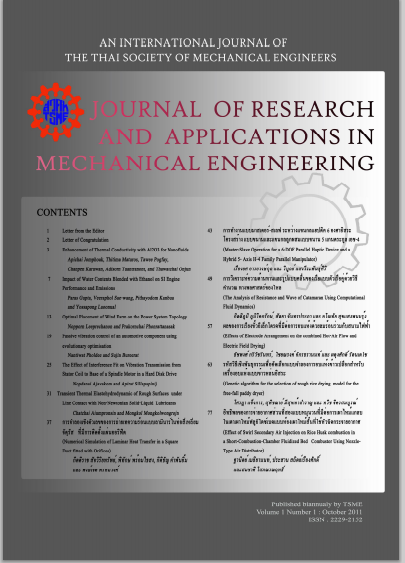Cooling rate and lower limit of subcooled film boiling around a vertical finite-length cylinder to subcooled tap water
Main Article Content
Abstract
The shape and thickness of the vapor film under the bottom surface are important factors to understand the convective heat transfer by film boiling around a vertical finite-length cylinder as the vapor generated under the bottom surface grows thicker during flowing up along the vertical lateral surface and the vapor film covering the cylinder governs the total heat transfer rate. Both thicknesses of the vapor film and the scale generated owing to tap water might be comparable during subcooled film boiling. Therefore, the effect of scale on the shape and thickness of the vapor film should be examined experimentally. In this study, quenching experiments on film boiling heat transfer around a vertical finite-length aluminum cylinder to subcooled tap water were carried out to clarify the cooling characteristics and examine the effect of scale on film boiling. The test in experiments is repeated ten times in subcooled tap water with a liquid subcooling of 15 K at atmospheric pressure. The diameter and length of the test cylinder are 32 mm and 32 mm, respectively. The test cylinder was heated to about 560 degrees C in an electric furnace and then cooled in subcooled tap water with a submersion depth of 150mm. The body temperature was measured by a K-type sheath thermocouple placed near the center of the cylinder. The behavior of the vapor film around the cylinder was observed with still photography and video camera. The experimental data were presented in terms of cooling curve and cooling rate curve compared with the thickness of the vapor film at the center of the bottom surface. The effects of scale and the thickness of the vapor film at the center of the bottom surface on cooling rate and lower limit of film boiling were discussed.
Article Details
This work is licensed under a Creative Commons Attribution-NonCommercial-ShareAlike 4.0 International License.
References
[2] Thomas, F.I.J. and James, P.H. (1975). Advances in HEAT TRANSFER Volume 11, ACADEMIC PRESS, New York, London, pp.51-124.
[3] Momoki, S., et al. (2009). Experiments and Analysis on Film Boiling Heat Transfer around a Finite-length Vertical Cylinder with a Convex Surface Facing Downward, J. Power
and Energy Systems, vol.3, no.1, pp.182-193.
[4] Momoki, S. et al. (2011). Effect of the Bottom Configuration on Film Boiling Heat Transfer from a Vertical Finite-length Cylinder, paper presented in Proc. of the ASME/JSME 2011 8th Thermal Engineering Joint Conference, AJTECH2011, AJTEC2011-44122, March13-17, 2011, Honolulu, Hawaii, USA.
[5] Momoki, S. et al. (2012). Effects of Bottom and Top Configurations of a Vertical Finite-length Cylinder on the Lower Limit of Film Boiling, paper presented in proceedings of the 3rd International Forum in Heat Transfer, November 13-15-2012, Nagasaki, Japan.
[6] Dogan, C. and Abdurrahim, B. (2011).The quenching behavior of aqueous nanofluids around rods with high temperature, Nuclear Engineering and Design, 241, pp. 2519– 2527.



